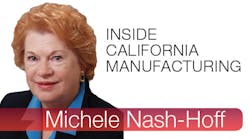If you are a lean manufacturer, does that mean that you are a lean enterprise?
At the recent Lean Accounting Summit put on by Lean Frontiers, Cheryl Jekiel, author of Lean HR, gave a keynote presentation on "The Future of the Horizontal Lean Enterprise, Rev Up Your Engines."
Jekiel led off by describing the support functions of a company (accounting/finance, information technology, human resources, quality, etc.) as "potentially the engine of the organization" in "driving strong performance."
She outlined six ways to power up support functions to create a different attitude in the whole team:
- "Gain clarity on how your work impacts your external customers.
- Shift attitudes beyond current expectations.
- Focus on highest priorities ─ what is the #1 problem in your business?
- Develop a service attitude – how do you measure service? Does it meet the needs of your customers? Survey internal customers (other departments).
- Synthesize skills of finance, IT, etc. and combine various items into a cohesive whole.
- Leverage diversity of skills ─ you are better together"
She recommended that companies "identify ways that support staff impact external customers, expect more of team members in support functions, and prioritize work based on ability to achieve objectives."
Retiring Association for Manufacturing Excellence President, Paul Kucharis, made a comment that has kept running through my mind, "What got you here, won't get you there." We have come a long way in the last 25 years since lean concepts, principles and tools diffused out of the Toyota Production System, but it is a never-ending road of continuous improvement to reach an ever-changing target. The underlying discussion among speakers and attendees of the summit seemed to be questioning whether enough progress had been made. The consensus from discussion was that we now have many companies that are lean manufacturers, but how many are lean enterprises? And, of particular importance to the theme of the summit, how many are using lean accounting rather than standard cost accounting?
This is why I selected the breakout session on Accellent Corp.'s "Solving the Standard Costing Problem," presented by Jeremy Friedman, president and COO of the Cardio & Vascular Division. Accellent (now Lake Region Medical) is a medical device manufacturer with 17 factories, 5,000 employees and 20,000 SKUs.
He said, "Standard cost accounting is incomprehensible; we didn't know where the numbers came from…Our prices were as high as three times competition. Standard costing didn't work for our 20,000 SKUs…There were too many assumptions, too many variances."
When he was the executive vice president and CFO, he researched the subject, read several books, and spoke to some of the experts, such as Jerry Solomon, Brian Maskell and Nick Katco, whom I met at the conference.
The company decided to eliminate standard cost accounting, and they made the switch to “plain English P & Ls” on October 1, 2012. Friedman said, "We began with value stream management and focused on cutting costs...We eliminated variance analysis and changed from using standard costs and adding a markup…We had to teach that pricing isn't a function of cost. Besides the benefits at the operations level, we are no longer pricing products at two to three times higher than competition. We changed to a new paradigm ─ lean cash flow." The old model was “What is the lowest price we can charge based on standard costs and markup?” The new is “What is the highest price we can charge and still win the business?”
The companies I represent sometime lose orders for being two to four times higher than the competition, so I have a very good reason for encouraging a transition from standard cost accounting to lean accounting. I firmly believe that if more companies would make this transition, we would be losing less business to China and other offshore suppliers.
Next, I attended the session on "Lean Product and Process Development ─ Creating the Future" by Dr. James Morgan, president of Emc Network and a senior advisor for the Lean Enterprise Institute. Dr. Morgan shared his experiences as the director of Global Body Exterior, Safety and SBU Engineering at Ford Motor Co. from 2006 to early 2013 when he left the company.
He said, "Every time you develop a new product, you have the opportunity to create/change the future...Apple and Google changed the future."
"In many companies," he commented, "new product development is a nightmare: design and quality problems, late launches, [etc.]…Great products drive enterprise growth and require interdepartmental collaboration…Lean product development requires that you develop the people and product simultaneously."
Morgan said that at the time of the economic crash in 2008, "Ford had $17 billion in losses over the previous three years and a 20-year market share decline…Ford's recovery was a product driven recovery based on a new product portfolio and new global development process.
The Body department was organized around the value stream and developing engineers was made a priority following the Technical Maturity Model (TMM), Technical Independent Development Process (TIPD), using mentoring and targeted assignments, and design reviews to demonstrate efficient design. They included the extended enterprise of the UAW and suppliers and used the Matched Pair Process for engineering and purchasing to shape processes, tools and objectives. They spoke as one voice."
In summary, he said, "They tightly synchronized activities to create effective concurrency and increase probability of success. The process they followed was:
- "Study - to create the right product
- Execution - to deliver the right product
- Reflection/learning"
He recommended that "you use A3 forms for business planning and align your organization with the right tools and stretch your team."
Does Your Company Have a Sustainable Lean Culture?
I attended two of the 20-minute "scrambles." The first was "Kata, Coaching and TWI" by Jim Huntzinger and Dwayne Butcher, the principals of Lean Frontiers. I was familiar with Training within Industry (TWI) from my Lean Six Sigma Yellow Belt class. It was briefly described as the program implemented during WWII to train women and non-military qualified men to replace men in industry that had been drafted. It contained three "J" programs: Job Relations, Job Instruction and Job Methods.
They explained that the objective of Coaching Kata is: "Create an organization that solves every problem every time...Coaching Kata shows how to develop problem solving skills one-on-one using PDCA in coaching/mentoring on actual projects." Huntzinger said, "You will not become lean by doing TWI, but you will not become lean without doing TWI."
To me, the last "scramble" of the day came full circle from the first keynote by Robert Miller on the future of Lean leadership and put everything into perspective ─ Orry Fiume's discussion of "Executive Leadership." He stated that whether or not your company has built a sustainable culture of excellence based on Lean principles can be easily determined by using the following simple comparison:
|
Traditional |
Lean |
|
Functional form |
Business form |
|
Managers direct |
Managers teach |
|
Management delegates |
Management supports |
|
Blame people |
Root cause analysis |
|
Us vs. Them |
Real teams |
|
Results focused |
Process focused |
|
Internal focus |
Customer focus |
|
Managers control |
Workers control |
|
Hierarchy |
Flattened organization |
|
Employee is a cost |
Employee is an asset |
|
Rewards individual |
Rewards group sharing |
I would add one more comparison to this matrix to fit the theme of the conference: traditional standard cost accounting vs. Lean Accounting.
Less than half the attendees and speakers were present for the final panel discussion on "Your Organization in 10 Years." The consensus of comments by panelists and members of the audience seemed to be that while the "Lean movement" has come a long way, many companies, still have a long way to go.
Within the San Diego region, I see many companies that participate in the CONNECT Operations Roundtable workshops apply lean principles and tools on the shop floor. They seem to have transformed from traditional companies to lean companies in about half to two thirds of the above matrix. However, I don't know of any company that utilizes lean accounting.
The problem is that most of these companies are medium to large companies. Very few companies under 50 employees have begun to adopt lean principles and tools. Only two of the small companies I have represented in the past 15 years have gone through lean training. The first was a metal stamping company with less than 40 employees. They obtained the training through one of the California Centers for Applied Competitive Technologies offsetting the cost with some funding from the Employment Training Panel. As a result, average throughput was reduced from five weeks to five days, on-time delivery improved by 70% and work-in-process was reduced by 40%.
The other company was a rubber molder with only 15 employees, and they received their training through the southern California Manufacturing Extension Program, California Manufacturing Technology Consulting. Their biggest benefit was eliminating wasted movement and time by implementing 5S and rearranging equipment. The cost of their training was also reduced by Employment Training Panel funding. Small companies have the advantage of not having much of a hierarchy to flatten, and the president has to be fully committed to becoming lean to even initiate the training. This makes it easier for lean to become integral to the culture of the company.
Utilizing lean tools is not enough to become a lean company. Lean concepts and principles must become part of the culture. Lean will not be sustainable in the long run unless it does.




